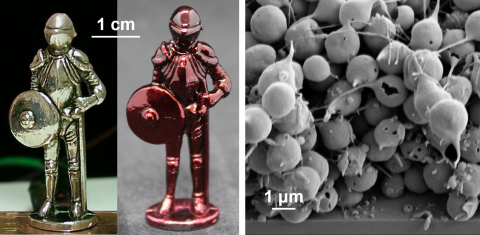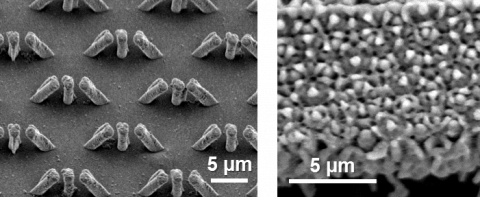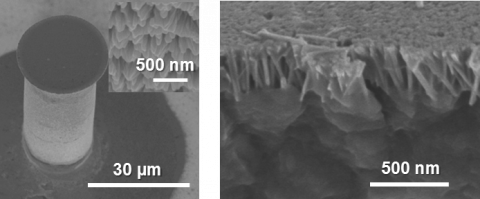Multiscale Spray

The electrospray process utilizes the balance of electrostatic forces and surface tension within a charged spray to produce charged microdroplets with a narrow dispersion in size. In electrospray deposition, each droplet carries a small quantity of suspended material to a target substrate. Past electrospray deposition results fall into two major categories: (1) continuous spray of films onto conducting substrates and (2) spray of isolated droplets onto insulating substrates. We are investigated a cross-over regime, or a self-limiting electrospray deposition (SLED), that has only been limitedly observed in the spray of insulating materials onto conductive substrates. In such sprays, a limiting thickness emerges where the accumulation of charge repels further spray. By the controlled application of such sprays we can apply uniform or controllably varied microscale coatings onto complex 3D objects and microscale targets. We have also demonstrated that forests of nanowires can be coated onto complex surfaces by in-air gelation of cellulose ethers during SLED spray, the first time this morphology has been observed.
Relevant Manuscripts
Green-Warren, R. A.; Bontoux, L.; McAllister, N. M.; Kovacevich, D. A.; Shaikh, A.; Kuznetsova, C.; Tenorio, M.; Lei, L.; Pelegri, A. A.; Singer, J. P.; Determining the Self-Limiting Electrospray Deposition Compositional Limits for Mechanically Tunable Polymer Composites, ACS Applied Polymer Materials, 2022.
Lei, L.; Gamboa, A. R.; Kuznetsova, C.; Littlecreek, S.; Wang, J.; Zahn, J. D.; Singer, J. P.; Self-Limiting Electrospray Deposition on Polymer Masks, Scientific Reports, 2020.
Lei, L.; Chen, S.; Nachtigal, C. J.; Moy, T. F.; Yong, X.; Singer, J. P.; Homogeneous Gelation Leads to Nanowire Forests in the Transition Between Electrospray and Electrospinning, Materials Horizons, 2020.
Kovacevich, D. A.; Lei, L.; Han, D.; Kuznetsova, C.; Kooi, S. E.; Lee, H.; Singer, J. P.; Self-Limiting Electrospray Deposition for the Surface Modification of Additively Manufactured Parts, ACS Applied Materials and Interfaces, 2020.
Lei, L.; Kovacevich, D. A.; Ryu, J.; Nitzsche, M. P.; Al-Marzoki, K.; Rodriguez, G.; Klein, L. C.; Jitianu, A.; Singer, J. P.; Thickness-Limited Electrospray Deposition for 3D Coatings, ACS Applied Materials and Interfaces, 2018.
Klein, L. C.; Kallontzi, S.; Fabris, L.; Jitianu, A.; Ryan, C.; Aparicio, M.; Lei, L.; Singer, J. P.; Applications of Melting Gels, Journal of Sol-Gel Science and Technology, 2018.
Laser-Induced Extreme Thermal Gradients

The opportunities presented by extreme spatial and temporal gradients to pattern nanostructures of desired composition are especially attractive. Specifically, by reducing the lengthscale over which interacting fields evolve and tuning the timescale during which they influence a material, it becomes possible to greatly magnify driving forces and exercise control over the full extent of their action. This, in turn, enables influence over the final morphologies and the properties that result from these morphologies while avoiding unwanted kinetic effects such as diffusion or degradation. The HMNL is actively investigating the use of extreme laser-induced thermocapillary forces for the patterning of polymer thin films, nanoparticles, and organic and inorganic nanocomposites via focused laser spike (FLaSk) excitation. The use of fundamental capillary driving forces allows for nanoscale directed assembly of these materials well beyond the intrinsic resolutions of the optically-limited free-space beams. Further, we can employ the thermal and fluid driving forces to conduct metrology on the film being excited. This allows for the rapid analysis of thin film materials such as polymer and metallic glasses.
Relevant Manuscripts
Ma, T.; Liu, A.; Buznitsky, K.; Nitzsche, M. P.; Yi, J.; Sridhar, A.; Chako, D.; Fakhraai, Z.; Singer, J. P.; Focused Laser Spike Dewetting to Probe Glass Transition of Soft Matter Nanofilms, chemRxiv, 2021.
Liu, N.; Ma, T.; Liao, C.; Ojeda Mota, R. M.; Liu, J.; Sohn, S.; Kube, S.; Zhao, S.; Singer, J. P.; Schroers, J.; Combinatorial Measurement of Critical Cooling Rates in Aluminum-base Metallic Glass Forming Alloys, Scientific Reports, 2021.
Ma, T; Nitzsche, M. P.; Gamboa, A. R.; Saro-Cortes, V; Singer, J. P.; Localized Physical Vapor Deposition via Focused Laser Spike Dewetting of Gold Thin Films, ACS Applied Nano Materials, 2, 1, 586-597, 2018.
Gamboa, A. R., Nitzsche, M. P.; Saro-Cortes, V.; Ma, T.; Lei, L.; Singer, J. P.; Thermocapillary Multidewetting of Thin Films, MRS Advances, 2018.
Bordeenithikasem, P.; Liu, J.; Kube, S. A.; Li, Y.; Ma, T.; Scanley, B. E.; Broadbridge, C. C.; Vlassak, J. J.; Singer, J. P.; Schroers, J.; Determination of Critical Cooling Rates in Metallic Glass Forming Alloy Libraries through Laser Spike Annealing, Scientific Reports, 2017.
Singer, J. P.; Thermocapillary Approaches to the Deliberate Patterning of Polymers, Invited Review for Journal of Polymer Science B: Physics, 55, 1649-1668, 2017.
Singer, J. P.; Kooi, S. E.; Thomas, E. L.; Focused Laser-Induced Marangoni Dewetting for Patterning Polymer Thin Films, Journal of Polymer Science B: Physics, 54, 2, 225-236, 2016.
Singer, J. P.; Gotrik, K. W.; Lee, J.-H.; Kooi, S. E.; Ross, C. A.; Thomas, E. L.; Alignment and Reordering of a Block Copolymer by Solvent-Enhanced Thermal Laser Direct Write, Polymer, 55, 7, 1875-1882, 2014.
Singer, J. P.; Lin, P.-T.; Kooi, S. E.; Kimerling, L. A.; Jurgen, M.; Thomas, E. L.; Direct-Write Dewetting of Polymer Thin Films by a Laser-Induced Thermal Gradient, Advanced Materials, 25, 42, 6100-6105, 2013.
Rapid Production of 3D Micro/Nanostructures

3D laser direct write is one of the most versatile techniques for the generation of designers architectures. It is limited, however, by the intrinsically serial nature of the direct write process. By the addition of interference-based, latent patterns within the photopatternable medium, either by pre-exposure by interference lithography or incorporation of locally diffractive elements, each individual patterned voxel results in a hierarchical 3D pattern. In this way, pattern multiplication is achieved while simultaneously shifting the burden of high resolution to the latent pattern. The resulting structures can be produced orders of magnitude faster than would be possible by 3D direct write along, and possess characteristic features that make them applicable to phoxonic and plasmonic applications. In addition, we have been pursuing a new class of molding resins which allow for porous nanocomposite materials ranging from 10s of nanometers to 10s of microns to be molded into replicas in a single step for structures with functional capabilities to be rapidly fabricated in a wide range of macroscopic forms.
Relevant Manuscripts
Hasan, M.; Patel, Y.; Gamboa, A. R.; Grzenda, M. J.; Saro-Cortes, V.; Mhatre, V.; Singer, J. P.; Shear-Induced Macropore-Infused Nanocomposite Epoxy Thermosets (MINET), Advanced Materials Interfaces, 9, 23,2200145, 2022.
Grzenda, M. J.; Singer, J. P.; Thermal Properties of Graphite Nanoplatelet-Epoxy Composites Formed through Scalable High Shear Exfoliation of Expanded Graphite, Journal of Micro- and Nano-manufacturing, 10, 1, 014501, 2022.
Grzenda, M. J.; Maia, M.; Costeas, A.; Ferri, P.; Diez, F. J.; Singer, J. P.; Low-Density Electronics Coatings for Air-to-Deep Sea Vehicles, Journal of Coatings Technology and Research, 1-12, 2022.
Singer, J. P.; Lee, J.-H.; Kooi, S. E.; Thomas, E. L.; Rapid Fabrication of 3D Terahertz Split Ring Resonator Arrays by Novel Single-Shot Direct Write Focused Proximity Field Nanopatterning, Optics Express, 20, 10, 11097-11108, 2012.
Singer, J. P.; Kooi, S. E.; Thomas, E. L.; Focused Laser Spike (FLaSk) Annealing of Photoactivated Chemically Amplified Resists for Rapid Hierarchical Patterning, Nanoscale, 3,7, 2730-2738, 2011.
Multiscale Forming

One barrier to the large scale manufacturing of multiscale components featuring nanostructured surfaces is the lack of a bridging technique between macroscale thermoplastic forming processes and nanoimprint lithography. This arises from the difficulty and cost of generating controlled nanostructures on complex geometries by conventional top-down approaches, compounded by the necessary destruction of any resulting reentrant structures (such as any feature patterned on a vertical wall) during rigid demolding. This limitation can be overcome by sacrificial template imprinting. In this way, we have produced bulk metallic glass (BMG) and polymeric structures simultaneously demonstrating features from the macroscale down to the nanoscale. The ability to pattern surfaces in a single step on length scales from cm down to nm is a critical step towards fabricating devices with complex shapes which rely on multiscale topography for their function, such as medical implants or antimicrobial components.
Relevant Manuscripts
Li, R.; Chen, Z.; Datye, A.; Simon, G. H.; Ketkaew, J.; Kinser, E.; Liu, Z; Zhou, C.; Dagdeviren, O. E.; Singer, J. P.; Osuji, C. O.; Schroers, J.; Schwarz, U. D.; Atomic Imprinting of Metallic Glasses, Communications Physics 1, 1, 75, 2018.
Hasan, M.; Shajahan, I; Gopinadhan, M; Ketkaew, J; Anesgart, A.; Cho, C.; Chopra, S.; Higgins, M.; Reyes, S.; Schroers, J; Osuji, C. O.; Singer, J. P.; 3D Compatible Sacrificial Nanoimprint Lithography for Tuning the Wettability of Thermoplastic Materials , Invited Manuscript for Journal of Micro- and Nano-Manufacturing, 6, 4, 041003, 2018.
Singer, J. P.; Pelligra, C. I.; Kornblum, N.; Gopinadhan, M.; Ketkaew, J.; Liew, S. F.; Cao, H.; Schroers, J.; Osuji, C. O. Multiscale Patterning of a Metallic Glass using Sacrificial Imprint Lithography , Microsystems & Nanoengineering, 1, 15040, 2015.
